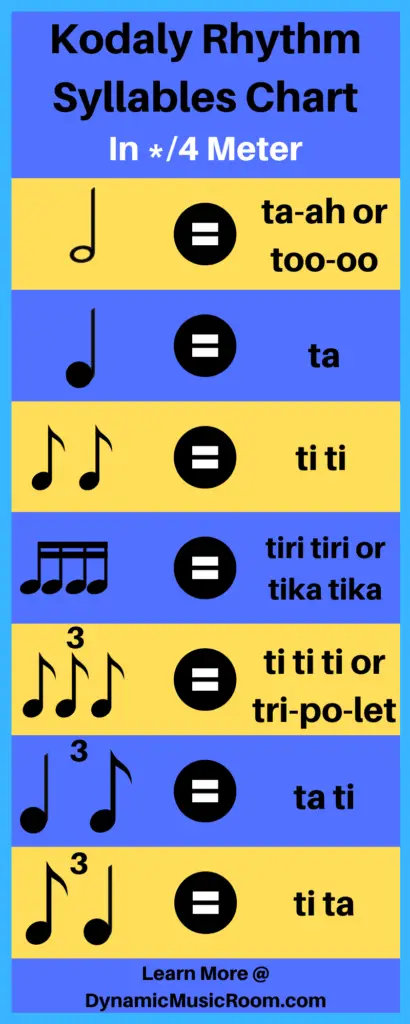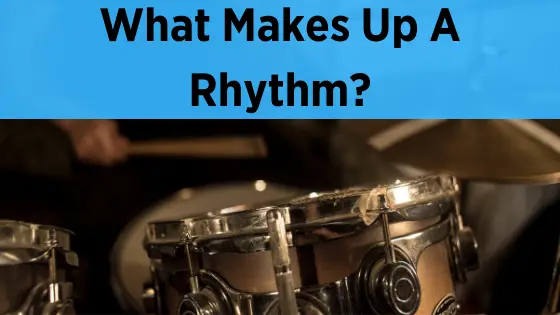Have you stopped to think about what exactly a rhythm is?
Are you trying to build your students’ knowledge about rhythms?
When one of my third grade students asked about what exactly a rhythm was, it got me thinking:
What makes up a rhythm?
Rhythm has been defined as sound patterns as they exist in time. In a more practical sense, rhythm can be considered patterns of different long and short sounds as they fit with beat, tempo, meter, and accent.
Read on for more details on rhythm, and you may find some ways to help explain rhythm to your students.
Table of Contents
4 Parts Of A Rhythm
In this section, we’ll look at the 4 parts of rhythm in both a more complicated language and in student-friendly language.
Beat
Without a semblance of beat, there can’t be rhythm or organized sound (which is one definition of music).
“The unit division musical time is called beat.”
Britannica
Beat is the pulse (steady or unsteady) which unifies music. Even unsteady beat still provides some context for the rhythmic patterns to exist over time.
Elementary Language: Steady beat is nice and even. It may be fast or slow, but it keeps the music together as the heart of music.
Secondary Language: Beat is a steady or unsteady pulse that holds the music together. When all elements are inside the beat, the music is united.
Check out our beat vs. rhythm activities for your kids.
Tempo
Tempo is Italian for “time.” In music, tempo refers to the speed of the beat often measured in beats per minute.
There are fast, slow, and moderate tempi. Rhythm exists within beat, and the tempo is a function quality of the beat.
Elementary Language: Tempo is how fast or slow the beat goes.
Secondary Language: Tempo is the speed of the beat. We measure this in how many beats there are per minute, but you still have leeway in deciding the exact tempo based on your own expressive preferences.
Meter
“Meter is a recurring pattern of stresses or accents that provide the pulse or beat of music.”
OnMusic Dictionary
Rhythm needs a meter in order for the written symbols to align. Even when elementary music teachers show rhythm patterns without a specified meter, there’s still the implication of meter (usually 4/4 or Common time).
Meter is broken down into the following terms:
- Simple Duple
- Simple Triple
- Compound Duple
- Compound Triple
- Complex
(There are more classifications you could use, but these are the 5 biggest.)
Elementary Language: Meter is the pattern on strong and weak (macro)beats. (Later on) These beats can be made up of two or three little (micro)beats.
Secondary Language: Meter is how many beats there are per measure and what kind of rhythm symbol gets the beat. It also tells you where to place accents naturally on the larger, macrobeats.
Simple Duple
The macro (or bigger beats) exists in a 2-beat pattern: Strong-weak (+ _ + _ + _ ). This is where the “duple” comes from.
Those macro/big beats are made up of 2 little beats, also called microbeats: (+ – + – ). This is where the “simple” comes from.
Putting it together looks something like this: (+ – _ – + – _ – + – _ -).
Time signatures may include:
- 2/4
- 4/4
- 2/2
Simple Triple
In simple triple, there is a strong-weak-weak macro beat pattern: (+ _ _ + _ _ ).
The macrobeats are still made of two microbeats: ( + – + – + -).
Put together, it looks like this: (+ – _ – _ – + – _ – _ – + – _ – _ – ).
Time signatures may include:
- 3/4
- 3/8 (if slow tempo)
- 3/2
Compound Duple
With compound duple, there is a strong-weak pattern of two macrobeats: (+ _ + _ + _ + _ ).
Now there are three microbeats making up the bigger beat: (+ – – + – – + – -). This is where the “compound” comes from.
When put together, it may look like this: (+ – – _ – – + – – _ – – + – – _ – – ).
Time signatures may include:
- 6/8
- 12/8
Compound Triple
With compound triple, the strong-weak-weak pattern of the macrobeat exists in groups of three: (+ _ _ + _ _ ).
The macro is made up of three microbeats: (+ – – + – – + – -).
Put together, it sounds like this: (+ – – _ – – _ – – + – – _ – – _ – – ).
Time Signatures may include:
- 9/8
- 12/4
Complex
Complex meter is a kind of catch-all term for any that don’t fit into this category.
They may use a macrobeat that isn’t 2 or 3, or they may have a microbeat that isn’t 2 or 3.
In some cases, they will use 2 or 3, but it may switch them up as you go.
Examples of some common time signatures include:
- 5/4
- 7/8
- 5/8
Accent
Accent is commonly defined as an extra emphasis on a particular rhythmic note, but this is just a simple definition. There are many types of accents which very in duration, weight, volume, and articulation.
Rhythms are much more than simple quarter notes; it also needs to involve this “accent.”
Accent also involves the strong and weak involved in meter, but it can be altered with style/articulation markings such as:
- Accent
- Staccato
- Legato
- Tenuto
- Marcato
Elementary Language: Accent is how we change rhythms to make them different from each other. Usually a little push.
Secondary Language: Accent means to play the note with a little extra volume, harder articulation, and shorter rhythm value. However, other markings can also emphasize notes by changing their length and dynamic.
What Is A Rhythmic Pattern?
With beat, tempo, meter, and accent in mind, we can now play patterns of long and short sounds to create rhythm. A rhythmic pattern is a snippet of these patterns isolated from some of the other elements.
This kind of rhythmic pattern gives us an idea of how something sounds, but it also exists outside of its greater context from a piece.
What Is A Rhythm Syllable?
Rhythm syllables are representations of rhythmic value used to help with the teaching and understanding of rhythm. There are many kinds of rhythm syllables out there to use each with their own pros and cons.
The goal of the rhythm syllable isn’t to replace the performance of rhythm but to provide a linguistic basis for learning and understanding rhythm in addition to its performance.
The next section breaks down 4 popular rhythm counting systems.
Read about the purpose of solfege hand signs for more info on learning tools.
4 Popular Rhythm Counting Systems
“Kodaly” Rhythm Syllables
This is probably the most common counting system with elementary music classes, but even within this system, there is some disagreement.
In general, Kodaly classes teach replacement syllables. This means certain rhythmic notations are replaced with phrases to help with learning.
Note: There is a movement which uses the Kodaly-based rhythms in a more beat function way.

Froseth/Gordon/Conversational Solfege
This rhythm syllable system was designed to mirror the tonguing of band students as they play by James Froseth in the later 20th century. It has since been adapted by Edwin Gordon’s Music Learning Theory and John Feierabend’s Conversational solfege.
Though it was intended originally for older students, it has gained quite a following in the elementary music world as well.
This is an example of a beat function rhythm system. Beat function refers to the syllables changing based on what gets the beat.
Example: “Du” will always be the sound you say when a rhythm lands directly on the beat. “De” will be the syllable you always say when the rhythm lands exactly halfway between one macrobeat and the next.
Here is one example chart of this from GIA publications (PDF at the link).
Note: Remember the syllables will match the value of the rhythm symbol that gets the beat.
Takadimi
The Takadimi system has its origins from Indian rhythm speaking. This system is widely used in sight singing and ear training classes at the collegiate level while there are some who use it in secondary and elementary schools.
Takadimi is another example of a beat function system as with Froseth syllables, but the words are derived from traditional syllables rather than looking to match the tonguing of band students.
Here is an overview of Takadimi syllables from Ball State University (PDF at link).
Note: Remember the syllables will match the value of the rhythm symbol that gets the beat.
Meter Counting/Number Rhythms
The meter counting system is the most popular counting system in the secondary performance classroom and with many private lesson teachers.
This is the way many of us were taught when we joined band, choir, or orchestra in middle school.
It requires knowledge and counting based on the meter.
The numbers of the beats will be counted depending on the meter.
Simple divisions are counted by “and”s. Compound divisions may be counted by “la-le” or “tri-plet”.
This system works well the more complicated the meter gets at higher levels of musicianship.
Here is a useful guide from MusicalU to get you started.
Rhythm Resources
Here are a couple of my favorite rhythm resources and some I’ve heard secondary performance teachers enjoy as well.
Rhythm Reading: Elementary Through Advanced Training: This book is very sequential. It does cost a bit more, but you can borrow and piece together your own rhythm exercises with this book.
Sight Reading And Rhythm Everyday: This book series is geared for piano students, but the exercises can be applied to other instruments and skills as well.
NotePerfectProject Rhythm Cards: I’m not very good at creating my own cards and such. I don’t have time for that.
But I love these because the cards are tough, writable, and wipeable. Plus, they’re pretty affordable as well (and this important because of our elementary music teacher salary).
Conclusion
Well, now you have some clues which may help you tell your students what makes up a rhythm better.
Remembering how beat, meter, accent, and tempo work together to form the basis for rhythm is a skill needed for higher-level music performance, and it can be started at the younger levels too.
In your own words, how do you define rhythm? Let us know in the comments below!


